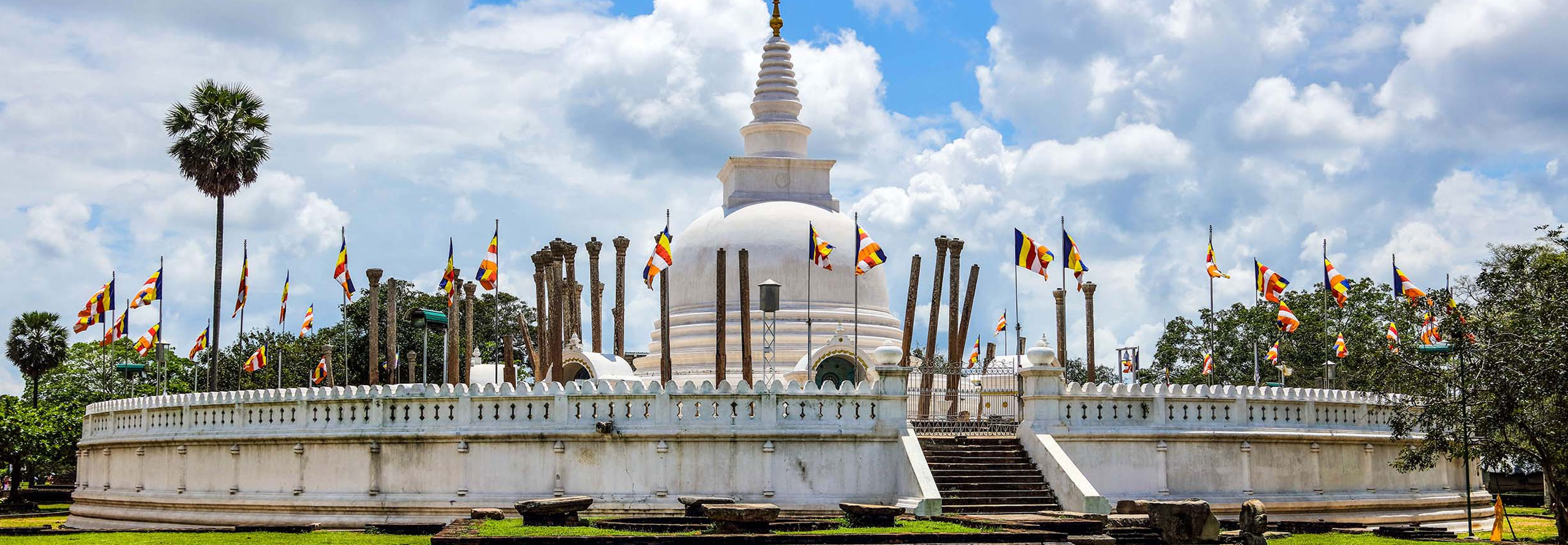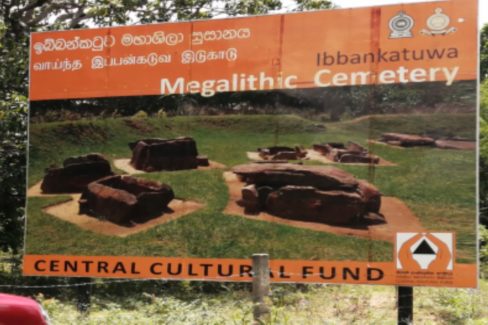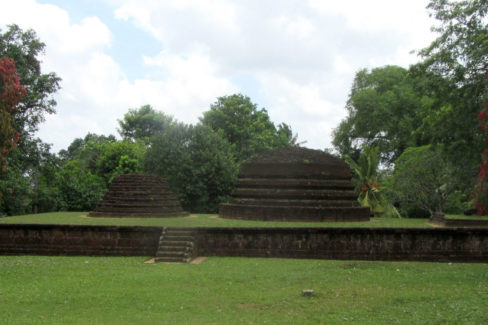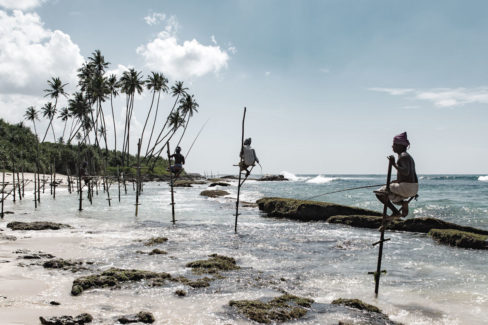The Main Places of Cultural Significance in Anuradhapura from 3 BC to 1 AD
Introduction
The Anuradhapura kingdom of Sri Lanka thrived during its time as the home place of establishing Buddhism in the island. From the arrival of Arahat Mahendra to the building of the stupa, pasada and other elements that coloured the society of that time, Buddhism has been the key thread that joins all these developments.
As per the legends, Arahat Mahendra indicated an area in Anuradhapura where the Maha Vihara should be situated. It is within this that these developments took place, particularly the building of stupa or dagobas as places of worship and veneration.
The Stupa or Dagoba
The stupa or dagoba is a significant feature in majority Buddhist monasteries of Sri Lanka and other South Asian countries. All stupas are said to enshrine in part or whole, corporeal remains of the Buddha or a saint. Thus the worshipper believes that in worshipping a relic of the Buddha is equivalent to worshipping the Buddha himself.
The predecessor to stupas are what is referred to as Chaityas. These existed even during the life of the Buddha himself. Hence the stupa is not strictly a Buddhist invention. However these Chaityas were not all structures like the stupa, some were even sacred trees used for worship. (Paranavitana, The Stupa in Ceylon, 1988).
Though stupas were originally built to enshrine relics of the Buddha himself, in later times the stupa were built to mark the sacred spots relevant to Buddhism such as the place where the Buddha delivered his first sermon or where he stopped to meditate. These stupas can be considered memorials (Foucher, L’Art Greco –Bouddhique du Gandhara, Tome I)
Thuparamaya
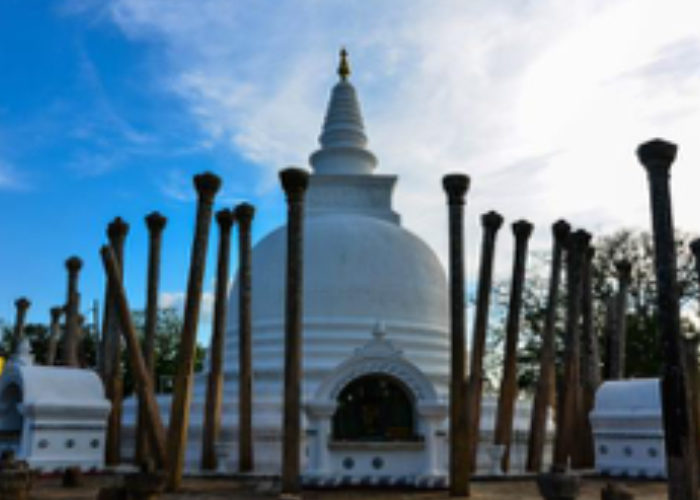
Buddhism became the state religion of Sri Lanka when King Asoka of India converted to Buddhism and sent a religious mission to Sri Lanka. This mission, considered a very important one, was entrusted to King Asoka’s son or brother, Mahendra who had taken holy orders. The reigning king of Sri Lanka at the time was Devanampiya also known as Tissa. He converted to Buddhism and it is he who built the first great stupa of Sri Lanka – the Thuparamaya. This stupa is said to enshrine the collar bone of the Buddha and is considered a place of great reverence even today. The stupa has undergone many changes over the years and its current form is not what it was originally.
There are details in the chronicles about the building and shape of this stupa. As per the Thupavamsa, the Thuparamaya was like a heap of paddy in shape and hence must have had a conical dome. (Pali Text Society, Edition, Page 50). This dhanyakara shape is one of six types of stupas recognized by the old craftsman of Ceylon (Paranavitana, The Stupa in Ceylon, 1988).
Sri Maha Bodhiya
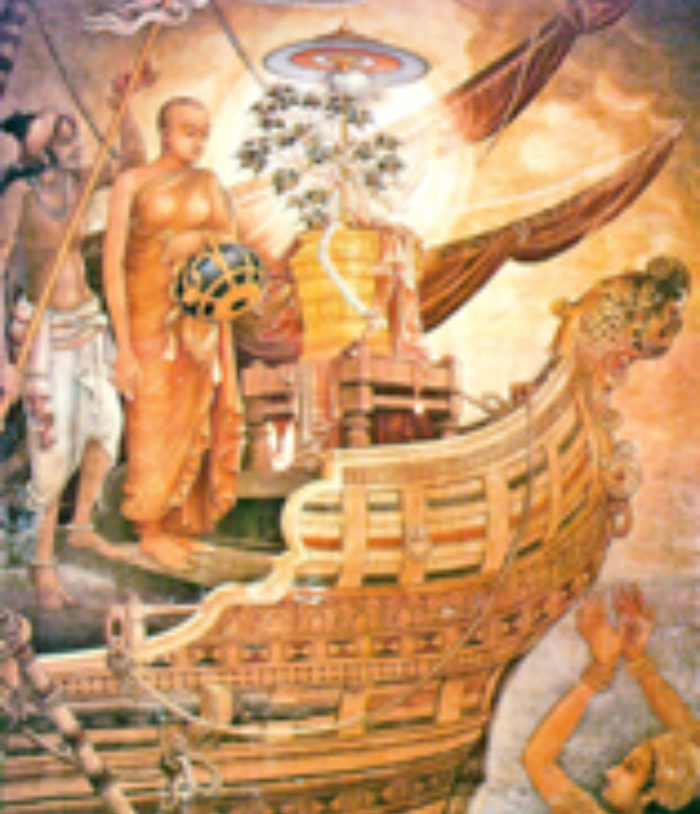
The arrival of a branch of the sacred Bodhi-tree in 236 BC marks a significant step in instilling the Buddhist faith in Sri Lanka. Brought by Sangamittha Theri, this branch was offered as a gift to Sri Lanka by Dhammasoka, the supreme ruler of India and a great advocate and missionary of the Buddhist faith. The Mahavamsa gives in detail the account of sending this sacred branch and how it was presented to King Devanampiya also known as Tissa.
The branch of the sacred Bodhi-tree from Bodh Gaya was brought and planted amid great ceremony in Anuradhapura in the Mahamegha grove. This account portrays how it was given utmost reverence and on it was bestowed the kingship of Lanka. (The Mahavamsa, XIX, Geiger’s Translation).
To date, the Sri Maha Bodhiya holds a special place in the heart of Buddhists in Sri Lanka as it is a branch of the sacred Bodhi-tree where the Buddha attained enlightenment. And its survival of over 2000 years is testament to its endurance and the endurance of the faith bestowed upon this island.
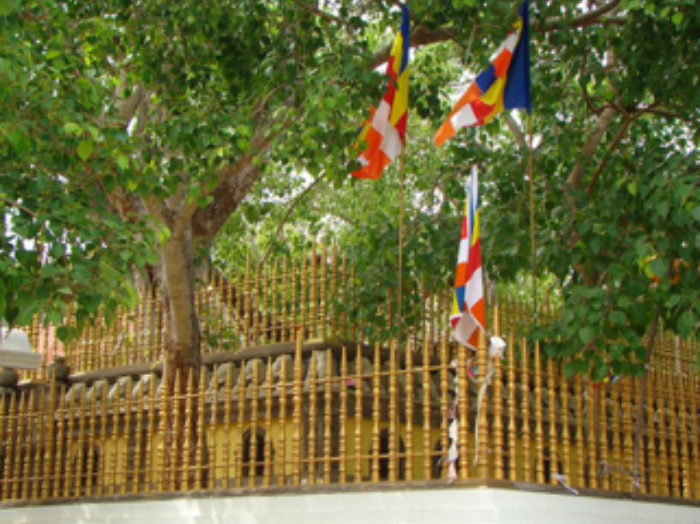
Mirisawetiya
After the invasion from India of Anuradhapura, in 101 BC, Dutthagamani managed to overthrow the invaders and became the sole monarch of Sri Lanka. He was a great Buddhist patron and is credited with building some of the greatest stupas in size and magnitude.
The Mirisaweti Dagoba is one such significant stupa which is said to have been built over the king’s scepter containing relics. The Mahamvamsa gives an account of the consecration of the Mirisaweti Viharaya after the King’s scepter containing relics was subjected to a miracle. (The Mahavamsa, XXVI, Geiger’s Translation).
The height of this stupa in olden times is said to have been 200 feet and the diameter at its base – 168 feet. The stupa is said to have been enlarged by Gajabahu I and has over time been repeatedly altered in design.
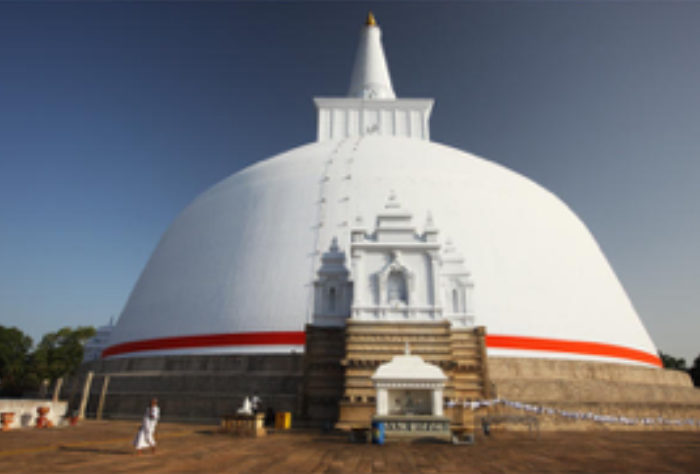
Abhayagiriya
The reign of Vattagamani Abhaya (circa 44 – 17 BC) is important for the further development of stupa in Sri Lanka. He lost his throne to South Indian invaders and as he was fleeing, he was insulted by a Jain ascetic who lived in a monastery to the north of Anuradhapura. After spending about 15 years in exile, Vattagamani Abhaya returned to his throne and remembering the insult by the Jain ascetic, he in retaliation demolished the hermitage to where the ascetic belonged and built in its place a vihara. This is the Abhayagiriya. It was erroneously referred to as the Jetawana but now is recognized correctly.
The Abhayagiriya was enlarged on two separate occasions after it was built. After its later enlargement it reached a height of 350 feet and has today, a diameter of 355 feet at the base. It stands now in a ruined state of 245 feet in height. Though greater in magnitude than the Mahathupa, to modern Buddhists it has no sanctity that can match its great mass. Although no great relic is mentioned with regard to this stupa, the spot is said to have been hallowed by the Buddha on one of his visits to Sri Lanka, where he rested a moment in meditation. (Paranavitana, The Stupa in Ceylon, 1988).
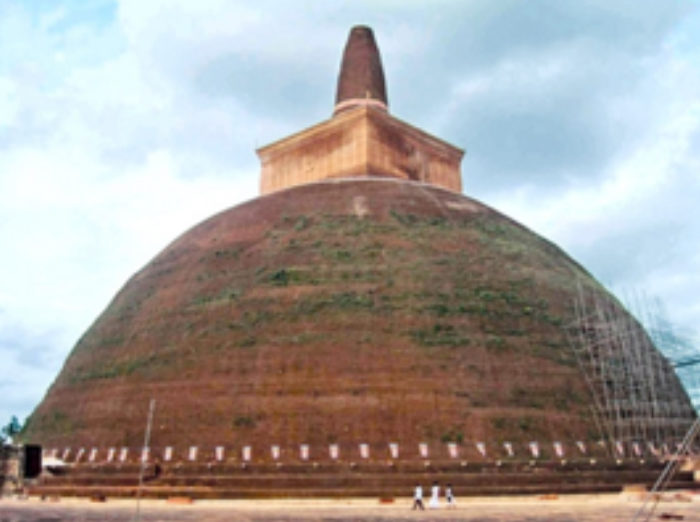
Mahathupa – Ruwanweli Dagoba
Known as the greatest work of Dutthagamani, this stupa is believed to contain the relics of the Buddha, originally deposited at Ramagama. When it was built, its height was 300 feet and the diameter of the base is 298 feet today. There is archaeological evidence to prove that this stupa when it was originally built is of roughly the same proportions as it is today. It was referred to as the Mahathupa because there was no other to rival it in size when it was built.
The Mahavamsa gives a very fanciful account of the building of the Mahathupa by Dutthagamani. It talks about the finding of the different materials in a manner ordained by the Gods. The bricks, the silver, the pearls and copper and how all these were found at the time by the King’s men to use to build this wonderful monument. (The Mahavamsa, XXVIII, Geiger’s Translation). The account is more legend than fact and yields little in terms of its accurate details. However amidst the legend there are a few architectural details that one can gather from this account.
“The Lord of the land had the place for the thupa dug out to a depth of 7 cubits to make it firm in every way. Round stones that he commanded his soldiers to bring hither did he cause to be broken with hammers, and then did he, having the knowledge of the right and the wrong ways, command that the crushed stone, to make the ground firmer, be stamped down by huge elephants whose feet were bound with leather. The fine clay that is to be found on the spot, for ever moist, where the heavenly Ganga falls down (upon the earth on a space) thirty yojanas round, is called, because of its fineness, butter-clay. Samaneras who had overcome the asavas brought the clay hither from that place. The king commanded the clay to be spread over the layer of stones and that bricks then be laid over the clay, over these a rough cement and over this cinnabar and over this a network of iron, and over this sweet scented marumba that was brought by the Samaneras from the Himalaya. Over this did the lord of the land command them to lay mountain crystal. Over the layer of the mountain crystal he had stones spread; everywhere throughout the work did the clay called butter-clay serve (as cement). With resin of the Kapittha-tree, dissolved in sweetened water, the lord of the chariots laid over the stones a sheet of copper eight inches thick, and over this with arsenic dissolved in sesamum oil, (he laid) a sheet of silver seven inches thick” (The Mahavamsa, XXIX, Geiger’s Translation).
Great care seems to have been taken in laying the foundation of the stupa to ensure it does not subside under its own weight. However, details such as the laying of the sheet of silver seem improbable and it is not possible to investigate and prove this either. (Paranavitana, The Stupa in Ceylon, 1988).
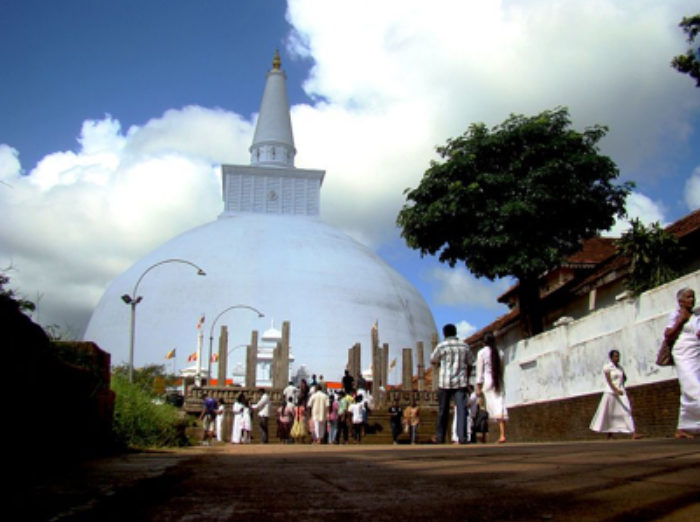
Lovamahapaya
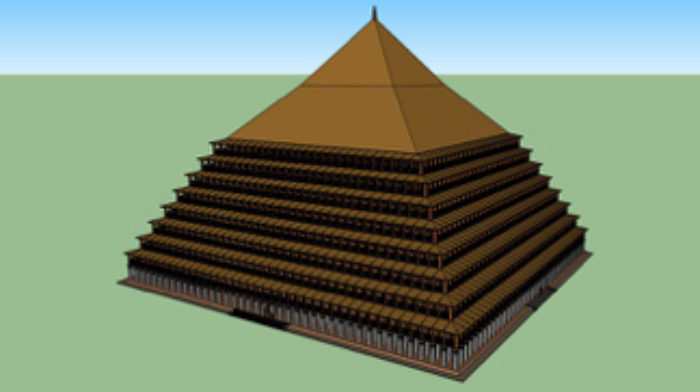
The Lohapasada or Brazen Palace as it is called, is a pasada built for the bikkhus by King Dutthagamani. According to the Mahavamsa narrative, the plan for the Lohapasada was drawn up by celestial beings and is thus described,
“Her gem palace was twelve yojanas high and measured forty eight yojanas round about; it was adorned with a thousand jutting window chambers, nine storied and provided with a thousand chambers gleaming with light, four sided with a thousand shell garlands and with windows as eyes and provided with a vedika adorned with a network of little bells.’ (The Mahavamsa, XXVII, Geiger’s Translation)
The pasada had four gateways and was surrounded by a beautiful enclosure. The pasada was covered in plates of copper and hence why its name – Brazen Palace.
The king bestowed the pasada to the Buddhist brotherhood at the consecration of the Mirisawetiya viharaya. (The Mahavamsa, XXVII, Geiger’s Translation)
Today this once magnificent structure stands in ruins, not showcasing the magnificence described in the Mahavamsa.
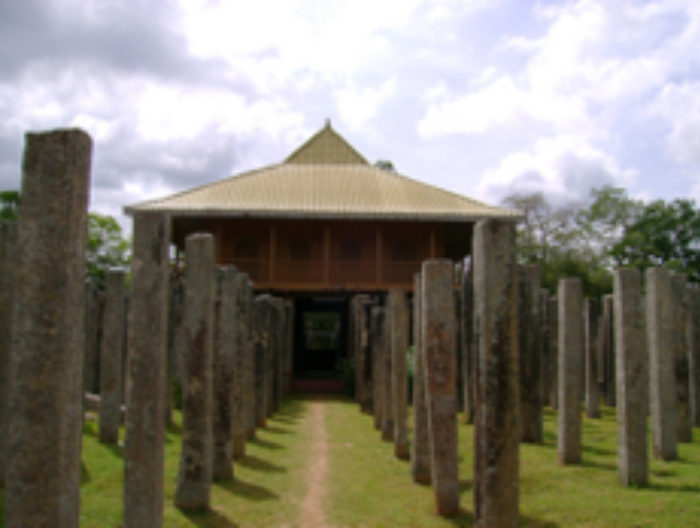
Dakkhina Stupa
This monument dating from the era of Vattagamani Abhaya was mistaken to be King Elara’s tomb. However it was later identified as being built in the 2nd Century BC by King Walagamba and is said to enshrine the remains of King Dutthagamani. It is located on Mihindu Mawatha, en route to the Sri Maha Bodhiya.
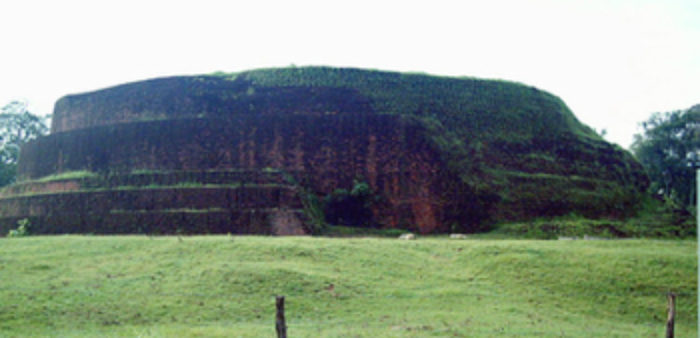
Conclusion
The socio cultural developments in Anuradhapura from the 3 BC to 1 AD are primarily focused on the spread of Buddhism and events related to it. The conversion of Sri Lanka to a primarily Buddhist nation happened during this period and the cultural advancements are directly linked to this. The development of a Maha Vihara complex and its relevant dagobas such as the Thuparamaya and Ruwanweliseya and important places of worship such as the Sri Maha Bodhiya are all linked to Buddhism.
The impact of the religion on the monarchs and people is clearly seen by the rapid advancement of the stupa and their spread especially in the ruling capital. This along with the spread of monasteries linked to these stupa clearly indicate that the transition to one official religion was accelerated through the monarchs such as Devanampiya also known as Tissa and Dutthagamani.
These places of cultural significance almost 2000 years ago, still hold a special place in the hearts of Buddhists in Sri Lanka today. The pilgrimage to Anuradhapura includes worship at these places which serve as beacons of a religion established to unify the country and which today has become a primary exponent of Buddhism unlike its neighbour India which was the birthplace of the religion.
References
Geiger, Wilhelm. Trans. The Mahavamsa or the Great Chronicle of Ceylon, 1912.
Paranavitana, Sarath. The Stupa in Ceylon. Volume 5. 1988
Seneviratne, Anuradha. Purana Anuradhapuraya, 1995

